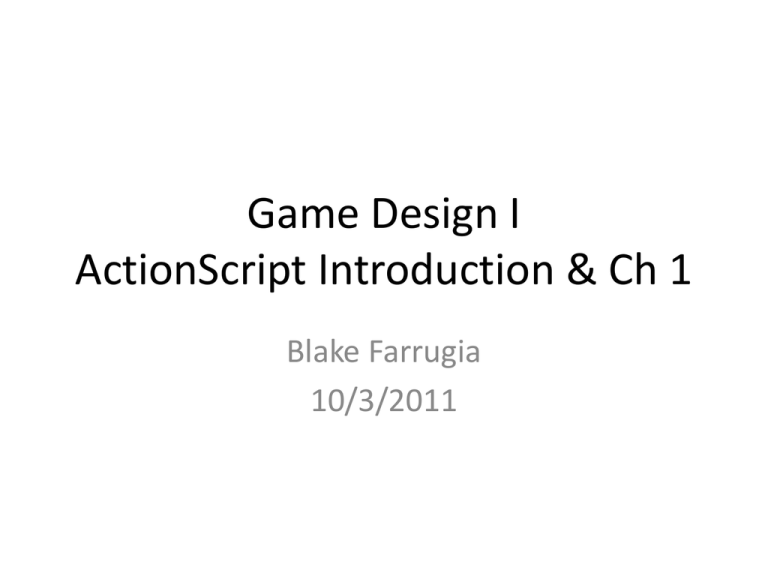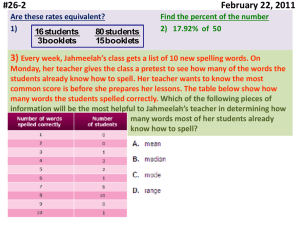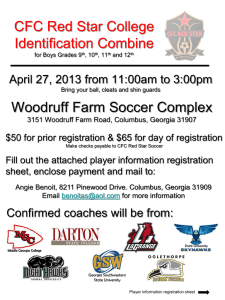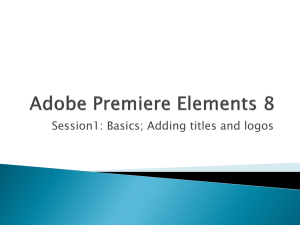Action Script Basics
advertisement

Game Design I
ActionScript Introduction & Ch 1
Blake Farrugia
10/3/2011
Specifics
• ActionScript was originally a small scripting
language built for Macromedia Flash
applications.
• Currently version 3.0, it is now a fully featured
object-oriented language for complex Flash
and Flex applications.
• Note: This includes games!
2
IDE Setup
• We all can’t have Adobe Flash, so here’s a
good freeware IDE : FlashDevelop
– Similar to Visual Studio
– Allows for quick debugging
– Installs most prerequisites needed for its use
– We will be using FlashDevelop 4.0 Beta 3, but it
should work with the latest version
– http://www.flashdevelop.org/
3
4
Basics
• FlashDevelop is very similar to Visual Studio
• The Flex SDK is needed. FlashDevelop should
install and configure this for you.
• A 32-bit Java Runtime Environment (JRE) of
v1.6 or greater is needed.
• The Flash Debug Player. It can be found here:
http://www.adobe.com/support/flashplayer/d
ownloads.html
5
Installing Flex SDK
• To develop ActionScript games, a Flash
installation is not needed.
• It certainly helps with art assets and
animation, but all that is needed is the Flex
SDK.
• http://www.flashdevelop.org/wikidocs/index.
php?title=AS3
6
Using FlashDevelop w/ Flex SDK
• Compile Workflow
– Add resources such as graphics, sounds and fonts
to your FlashDevelop project
– Use FlashDevelop to write ActionScript classes
– Use embed tags in your ActionScript to include
assets
– Use FlashDevelop to compile your project using
the Flex SDK
7
Important Classes
• MovieClip – classes that act as dynamic
objects to be manipulated
• These objects use depth
to track asset display over each other.
8
Important Classes cont.
– bg.addChild() is adding a new instance of the asset
BgGif to MovieClip bg (itself)
– The Game class then calls addChild(bg) so it can
display MovieClip bg within the game
9
Important Classes cont.
• Sound – a sound asset for the game
• For Chapter 1, an asset is embedded as a
custom class PopSound, then PopSound is
applied
• Play a sound use
popSoundChannel=popSound.play(0,1);
10
Important Classes cont.
• This works for now, but a better way will be
introduced later in the book
• The authors introduce a set of game
framework classes in the chapter 2
11
ActionScript 3 Introduction
• Before we start developing, we will be
reviewing some basic language points.
– Variable typing
– Function declaration
– Reference import
– Class inheritance
– Labels
12
Some Basics
• ActionScript 2.0 is NOT ActionScript 3.0. Some
of AS2 will not work with AS3.
• Syntax – function/variable type after name
13
Syntax Notes
• Much of the language writes like C#/Java
• Much like the languages mentioned above, it
is VERY object-oriented.
• Function and variable typing syntax differs the
most from other languages, as seen above.
14
Embedded Resources
[Embed(source = 'assets/blade.gif')]
public static const BladeGif:Class ;
• Embedding resources create class objects out
of our art/sound assets for use later
• This keeps OOP standards while inserting art
assets into the script
15
Variable Typing
• To declare a variable of a certain type, it must
follow this format:
– AccessLvl var variableName:Type ;
• public var someInt:Int = 3214;
• var someString:String = “This is a string!!”;
• public static const someImportantNum:Number = 0;
16
Variable Typing
• Variables follow standard scope rules
• Variables can only be used in functions,
classes, and/or namespaces you use!
17
Function Declaration
• Functions do not need to be prototyped and
they follow a similar declaration as variables.
– AccessLvl function functionName:Type( … ) { … }
18
Function Declaration
public function doMath:Float(x:Float, y:Float)
{
var tempVar:Number = x;
var answerVariable:Number = x * y / x;
return answerVariable;
}
private function doNothing:void() { }
19
Reference Import
• With package being the namespace of the
class, import calls take all references
• .* get all classes
• Classes follow
• Imports can be
done anywhere
wrt scope!
20
Class Inheritance
• Use the extends keyword to get functionality
of another class.
• You can override base functions by using the
override keyword.
• On the topic of classes, structs DO NOT exist in
AS3. Too bad!
21
Chapter 1-1 : Balloon
• At time of writing, Chapter 1 code did not use Flex SDK.
Much of it is wrong.
• The original code does not use embedded resources
and lacks many classes. It will not work properly.
• Much of the actual book material is accurate, but in
this case, the code from CH1 is not.
• Revised code can be found along with a description of
fixes http://www.8bitrocket.com/2010/3/29/EssentialGuide-To-Flash-Games-Code-Supplement-1-Ch-1Games-With-The-Flex-SDK/
22
Game Basics
• Player : A large spinning saw blade
• Enemies : Balloons
• Objective: Pop the balloons with your spinning
blade!
• Source Code : Game.as
• Any assets (graphics, sounds) are in the
revised code’s asset folder:
– /ch1_balloons/src/assets
23
Game.as
• Main class of balloons.swf
• Game functions. Each below are described in
the sample code :
– Game “Loop”
– Collisions
– Object generation/tracking
– Events
24
Framework
• Game Loop – game state management
– Called via event that is triggered by new frames
– Switches “game states,” paths of different code
25
Framework - Initialization
• Where all variables and display assets are
loaded. Classes can be modified by reference.
26
Initialization cont.
• What is this function doing?
– Initializing MovieClip player and assigning BladeGif
as it’s only displayable feature
– Initializing MovieClip array enemy to an empty
array
– Add player to Game’s Displayable Object List and
set up important data ( level, chances )
– Set Game’s gameState to STATE_PLAY, allowing
game to be played
27
Framework – Play Game
28
Framework – Play Game
• playGame() runs each function or stage of the
game.
• makeEnemies() – Randomly create enemies
• moveEnemies() – Update enemy wrt speed
• testCollisions() – Check player collisions against
all enemy collisions
• testForEnd() – Check win/lose conditions
29
makeEnemies()
30
makeEnemies()
• Pseudo-random chance to add 1 enemy
variation with a speed based on current level
to array of enemies
• Sets all attributes of enemy after creation
– Location (x, y)
– Speed
31
moveEnemies()
32
moveEnemies()
• Moves balloons upward based on their speed.
• If they reach past the window bounds, then it
is counted as a “miss.”
• The player only gets 5 misses before the game
ends (abruptly)
33
testCollisions()
34
testCollisions()
• MovieClip collisions are based on bounding
boxes they create/update on initialization with
an asset.
• Custom collision boxes can be made.
• This function checks if any enemy is colliding
with the player.
• If so, they are “popped” and the player is
given a point
35
testCollisions()
• The splice(int index, int howMany) removes
element at index, and however many other
elements after (howMany)
36
testForEnd()
37
testForEnd()
• Check ending conditions
– How many misses? / Has Player reached Top
Score?
• Since gameLoop always checks gameState;
this registers our game over, or just increases
the level / difficulty
38
What’s Next?!
• Well, like all games, everything is in a loop.
• All of these functions will repeat based on the
gameState path chosen via int constants.
– STATE_INIT: initialize game
– STATE_PLAY: continuously update running game
– STATE_END: end game sequence
• Very basic, but a good standard to follow for
simple games
39
Chapter 1-2 : Pixel Shooter
• Much of “Balloons” is in Pixel Shooter
• This will talk more about major changes to the
framework rather than note every minor
change.
• Any new syntax will also be described.
40
Game Basics
•
•
•
•
•
Player : A spaceship
Enemies : Alien spaceships
Objective: Kill the alien ships
Source Code : Game.as
Any assets (graphics, sounds) are in the
revised code’s asset folder:
– /ch1_shooter/src/assets
41
Major Framework Changes
• Much of the framework is in tact, but this
game now adds player lives to the mix
• Multiple lives and player restarts are
controlled by the state system by using
STATE_START_PLAYER
• Projectiles are new as well, so new collisionhandling and events were added.
42
Framework - Initialization
• Two new states:
– STATE_START_PLAYER : adds player to game
– STATE_REMOVE_PLAYER : resets game
43
Framework - Initialization
44
startPlayer() and removePlayer()
• startPlayer() – very basic; add player back to
game, return to playing the game
• removePlayer() – reset level; remove all
enemies, missiles, explosions, and player from
the screen, then change state to recreate
player.
45
Anything Else?
• Though the framework is the same, many new
helper functions have been added.
• Each builds on what has already been
established in “Balloons”
– removeEnemy, Missile, Explosion () – remove
instances of any called item above
– makeExplosion() – create explosion animation
– onMouseDownEvent() – player-triggered event!
46
onMouseDownEvent()
• This event was initialized on the first line of
the initGame() function.
• When the player left clicks the mouse, a
missile will be fired his ship.
• Movement and collision of the missile will be
tracked by the game in moveEnemy() and
testCollision()
47
Tutorials
• 8 bit Rocket – Book authors website : Mostly
up to date tutorials in ActionScript 3
http://www.8bitrocket.com/
• Apress Book Website : Site that has all sample
code to the book
http://www.apress.com/9781430226147
48






